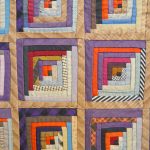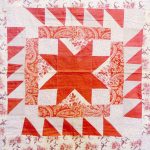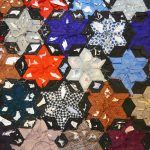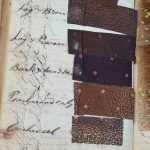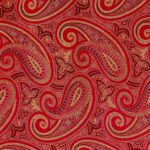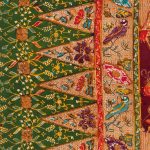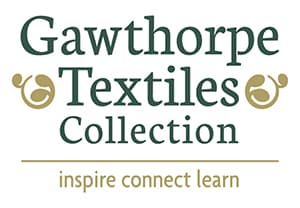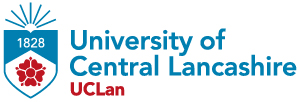This log cabin patchwork is believed to have been used as a ‘carriage rug’. Carriage rugs were made from thick, warm materials and were draped over the knees and legs whilst travelling in a carriage to help protect against chills and draughts. The many overlapping strips of fabric used to make log cabin patchwork create […]
View moreThis small patchwork coverlet is probably a cot cover and has been made by piecing without paper templates. The design has a frame layout, where concentric borders frame a central panel. Squares, strips and triangles have been used to create several different borders including examples of the patterns ‘tree everlasting’ or ‘flying geese’ and saw […]
View moreThis unfinished patchwork is made using the English paper piecing technique. Diamond shaped papers have been covered with fabric and arranged into a pattern of colourful stars formed by six diamonds within a framework of darker diamonds. The covered paper shapes are joined together by overcast or whip stitching. The design effectively uses high contrast […]
View moreThis book comes from Rosebank Mill in Lancashire and contains samples of mainly dress fabrics. Most of the samples are printed on smooth, evenweave cotton although there is one sample of cotton with a ribbed pile like corduroy. The cover bears the name Thomas Comstive and indicates that the book covers the period “1832 and […]
View moreExploring the connections between two iconic dyes and the story of William Gatty and his home; Elmfield Hall in Accrington.
View moreThis sample is one of a set of over 90 print samples attributed to the Robert Hindle & Co Print Works in Sabden, Lancashire. The vibrant colours of the samples are a perfect example of the impact that aniline dyes had on the dyeing and printing industries. The first aniline dye was mauveine or ‘Perkin’s […]
View moreThis sample is one of a set of over 90 print samples attributed to the Robert Hindle & Co Print Works in Sabden, Lancashire. The vibrant colours of the samples are a perfect example of the impact that aniline dyes had on the dyeing and printing industries. The first aniline dye was mauveine or ‘Perkin’s […]
View moreFinely woven Kashmir wool shawls from India became status symbols in Europe in the 18th century, and were considered the height of fashion up until the 1870s. As highly desirable commodities, factory-owners in Europe were quick to capitalise on their appeal and employed new industrial machine weaving methods to maximise profits. Towns such as Norwich, […]
View moreThe elaborate pattern and vibrant colours of this Malaysian batik sarong would have required a great deal of skill to create and the finished garment would have been a status symbol for the wearer. The complex design features peacocks as well as other birds, butterflies and a variety of floral motifs. At least six different […]
View moreThis sample is one of a set of over 90 print samples attributed to the Robert Hindle & Co Print Works in Sabden, Lancashire. The vibrant colours of the samples are a perfect example of the impact that aniline dyes had on the dyeing and printing industries. The first aniline dye was mauveine or ‘Perkin’s […]
View moreThis sample is one of a set of over 90 print samples attributed to the Robert Hindle & Co Print Works in Sabden, Lancashire. The vibrant colours of the samples are a perfect example of the impact that aniline dyes had on the dyeing and printing industries. The first aniline dye was mauveine or ‘Perkin’s […]
View moreThis sample is one of a set of over 90 print samples attributed to the Robert Hindle & Co Print Works in Sabden, Lancashire. The vibrant colours of the samples are a perfect example of the impact that aniline dyes had on the dyeing and printing industries. The first aniline dye was mauveine or ‘Perkin’s […]
View more